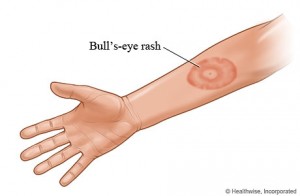Just One More Thing…

by Eric Gibson
Congratulations, you’ve survived the summer! What does that even mean? Not that death comes any easier to residents of South Florida in the summertime, but let’s admit it…the heat is killer! It’s inescapable. What else? Your kids were home all summer…driving you crazy. You survived that. Maybe you took a trip? How did it go? Did you survive? Did you drive on the right side of the road (if you were on U.S. territory)? Did you avoid contracting Malaria? Yellow Fever? Dengue Fever? West Nile Virus? You did? Good. Your survival is most likely the result of a well-researched, cautious and practical lifestyle. Smart people survive, and I know you’re one of them! So here’s a little bonus knowledge on just another danger you have to avoid in life so you can survive that, too: Lyme disease. You’ve heard of it, but do you know anything about it? Is it deadly? How do you get it? Is it treatable? Stay tuned…
 Lyme disease was first discovered in the U.S. in 1975 and was named after a town in Connecticut, where the first cases occurred. Lyme disease is caused by the organism Ixodes scapularis, which is exclusively transferred by the Deer Tick. Between the years 2003 and 2011, an average of 25,000 cases of Lyme disease were reported annually. Lyme disease transmission in Florida is extremely rare (30-78 cases yearly), so it is something to look out for when visiting the Northeast.
Lyme disease was first discovered in the U.S. in 1975 and was named after a town in Connecticut, where the first cases occurred. Lyme disease is caused by the organism Ixodes scapularis, which is exclusively transferred by the Deer Tick. Between the years 2003 and 2011, an average of 25,000 cases of Lyme disease were reported annually. Lyme disease transmission in Florida is extremely rare (30-78 cases yearly), so it is something to look out for when visiting the Northeast.
To fully understand the “hows” of Lyme disease, it is best to track its progress from beginning to end (“end” meaning transmission to a human host). The disease originates in wild rodent populations. The rodents will carry the organism Ixodes scapularis. The rodents will also serve as the primary host of nymphal Deer Ticks. The ticks will pick up the disease organism when they feed on the infected rodents, then they will look for a bigger host for their final blood meal before reproduction. Bigger host…you guessed it. It’s either us or the deer. Don’t hit anymore deer on the road. Increases our chances…
Symptoms
Lyme disease symptoms either come in the form of both flu-like symptoms and an easily recognizable rash or just the flu-like symptoms.  The rash is circular, with a lighter color in the middle…like a bull’s eye. This is your body’s way of letting you know the exact location that you contracted the disease. How convenient…
The rash is circular, with a lighter color in the middle…like a bull’s eye. This is your body’s way of letting you know the exact location that you contracted the disease. How convenient…
The rash doesn’t itch, but it’s warm to the touch. It will appear 3-30 days after the tick bite and last for four weeks. See a doctor as soon as you see or feel symptoms.
Treatment
Good news: Lyme disease CAN be treated. Yay! Just see your doctor. They may provide you with antibiotics for any possible infections that you may have developed caused by the tick bite. Bad news: if gone untreated, Lyme disease can cause arthritis, cardiac disease and neurologic disorder. More bad news: Lyme disease isn’t like the Chicken pox. There is no immunity. Once you have Lyme disease, you can get it again. Your pets can also get it, too. So, do your best to avoid any possible tick bites!
Prevention
Preventative measures solely consist of avoiding tick bites when outdoors:
 Stick to sidewalks and mowed grass. Avoid walking through dense brush.
Stick to sidewalks and mowed grass. Avoid walking through dense brush.- Wear long sleeve, light-colored shirts and pants (ticks are easier to spot on light colored clothing) tucked into socks. (Basically dress like Steve Urkel).
- You may apply tick repellant to your socks and shoes (so you smell funny, too).
- Inspect yourself and others after walking through dense brush.
- Children should be supervised when hiking outdoors (not just an anti-tick approach).
Now that you know a bit more about Lyme disease, where it comes from and how to prevent it, you can now start to develop and implement your new Lyme disease survival techniques. Be aware that if you live on a property where there are many wild animals roaming around, you may want to call a pest control professional to inspect your property for ticks. Other than that, keep on livin’! Keep on survivin’!
Eric Gibson is the Director of Marketing for Nozzle Nolen, Inc. of 5400 Broadway, West Palm Beach 33407. For more information about Nozzle Nolen, please visit www.nozzlenolen.com on the web, http://facebook.com/nozzlenolen on Facebook or call (561) 578-4787.
Nozzle Nolen is a member of the U.S. Green Building Council (USGBC). For more information about Nozzle Nolen and its Certified Green Solutions Program, visit www.nozzlenolen.com or call (800) 22-NOLEN.


Pingback: Signs Of Lyme Disease From A Tick Bite - The Details Of My Lyme Disease Diagnosis And How I Found Out I Had Lyme Disease | The Health Guide